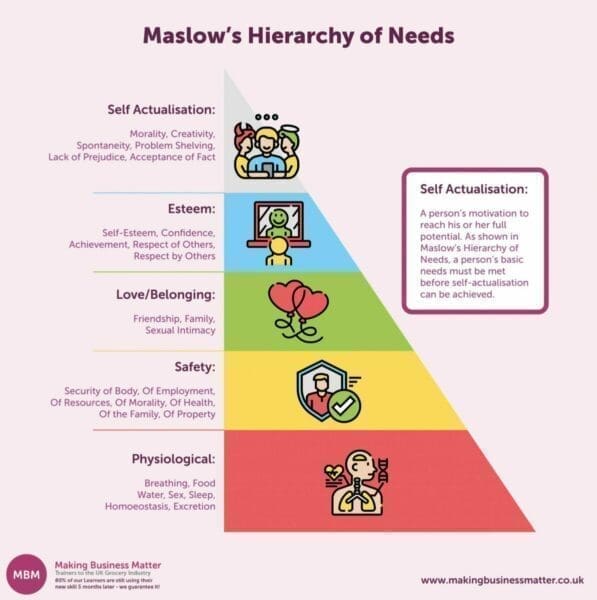Is Maslow’s Theory of Motivation’s Self-Actualising Goal Still a Great Vision for Today?
What motivates you in your job? How can you best inspire your team? Maslow’s Theory of Motivation proposes that what drives us is a hierarchy of needs that we all share. You start by satisfying your most basic needs and work up to what Maslow called ‘self-actualising.’ Becoming the best version of you, as the saying goes.
Abraham Maslow published his Theory in WW2. His learnings about realising our potential still resonate, in the uncertainty of the pandemic. But are they the best vision to follow?
In this article, we revisit Maslow’s theory and weigh it against other ideas. COVID has affected how we fulfil our needs, as identified by Maslow. We consider how businesses apply his theory to team building and project management. And we end by seeing how to achieve self-actualisation in the workplace.
What is Maslow’s Theory of Motivation?
American psychologist Abraham Maslow wrote “A Theory of Human Motivation” in 1943. As mentioned, the theory proposes humans have a hierarchy of needs that drive us. Known today as Maslow’s Hierarchy, these needs are physiological, safety, social, esteem and self-actualisation.
How Would You Relate Maslow’s Hierarchy of Needs?
In plain language, the more you satisfy your needs, the stronger your wellbeing will be. Particularly those further up the hierarchy.
What is the Pyramid of Needs?
People refer to Maslow’s hierarchy as a pyramid of needs. This is because the proportion of people reaching each stage gets smaller as you climb the levels. Like a pyramid, in fact.
What’s in the Hierarchy?
Maslow identified the following needs in ascending order:
Physiological: Such essentials as food and drink, and sleep.
Safety: Physical security, freedom from danger and pain.
Social: Friendship, giving and receiving love, joining in social activities, being part of a group.
Esteem: This includes self-respect and the esteem we receive from others. Esteem includes a desire for self-confidence and achievement, and recognition and appreciation.
Self-actualisation: Maslow was convinced that humans’ ultimate desire is to realise their full potential. He wrote, “A man’s desire for self-fulfilment, namely the tendency for him to become actualised in what he is potentially: to become everything one is capable of being.”
Click the image below for a higher resolution.

LACKING A STRONG PURPOSE CAN DAMAGE YOUR HEALTH!
As it turns out, it’s not exaggerating to say that. The pandemic’s made it more important than ever to strive for fulfilment and give your life meaning and purpose. Part of self-actualisation – the topmost need in Maslow’s hierarchy – purpose helps keeps us alive. And the medical evidence supports this.
Dr Alan Rozanski is a New York cardiologist. His 2019 paper “Association of Optimism with Cardiovascular Events and All-Cause Mortality” is carefully worded but clear. “The findings suggest a mind-set of optimism is associated with lower cardiovascular risk… Promotion of optimism and reduction in pessimism may be important for preventive health. “
How has COVID Tested Maslow’s Hierarchy?
Focusing on life in Britain, COVID has affected the attainment of our needs, as defined in Maslow’s hierarchy. Here’s how:
Physiological: With many industry sectors still disrupted, it remains hard for millions to get the basic needs. The food banks and relief charities continue doing a heroic job. Meanwhile, concerns about health and resisting infection have made food supplements and vitamins essential requirements for many. With anxiety levels heightened, calm, sleep and rest are at a premium.
Safety: These needs are precarious in the pandemic, with job losses and furloughing, work scarce and personal finances stretched. ‘Safety needs’ include shelter, job security, health and a safe environment. Meanwhile, people with money have been spending on insurance and alarms, and thinking about their finances.
Belongingness and love: Pandemic restrictions have stretched these particular needs for many of us. People living alone have relied on social media, the phone and online to sustain them. We have compensated by shopping, online particularly. Clothing and grooming products are a major comfort.
Esteem: We’ve turned to ‘social,’ including LinkedIn, for our fixes of self-esteem and desire for reputation. In marketing terms, this segment of the Hierarchy is where cars, furniture and credit cards come into play. For those who can afford them.
Self-actualisation: The pandemic’s denied us face to face opportunities for personal growth and experiences, but they’re starting to return. Hobbies and physical fitness have kept people going over the months. UK holidays have been allowed for some time, but foreign travel remains complicated.
Taking a Wider Look at Motivation Theories
To see Maslow’s Theory in perspective we must consider some other motivation theories.

What are the 3 Theories of Motivation?
- Optimal level: French physiologist Claude Bernard’s term ‘Homeostasis’ describes maintaining an optimal level of needs that give us balance. This is also known as the drive theory. We’re motivated to take certain actions to reduce the internal tension caused by these unmet needs. For instance, at a physiological level, we’re motivated to drink water, to reduce our internal state of thirst.
- Psychoanalytic theory: Sigmund Freud said our inborn tendencies affect our behaviour. He spoke about our life instincts having the life energy called Libido. This motivates us to constructive things like love, sympathy and compassion. Meanwhile the death instincts (Thanatos) motivate destructive activities like murder, aggression, attacks and suicide. Freud also said our unconscious motives play a more dominant role than our conscious ones.
- Humanistic Theory: A more positive notion than Freud’s, this is based on individuals striving to realise their potential. We reach out creatively, strengthening self-confidence and reaching our ideal self. Maslow’s Theory fits well with this. The other important figure here is Carl Rogers. He was best known for developing client-centred therapy, so important in restoring wellbeing. Rogers believed all humans have one basic motive, to achieve the best version of ourselves. This resonates with Maslow’s self-actualising model.
What are the 4 Theories of Motivation?
Lumen Learning identifies four need-based motivation theories:
- Maslow’s Hierarchy of needs
- Alderfer’s ‘ERG’ theory
- Herzberg’s dual factor theory
- McClelland’s acquired needs theory
Let’s look at these:
Clayton Alderfer’s ERG theory, devised in 1969, modifies Maslow’s hierarchy. Alderfer regroups the five human needs into three. They match up with Maslow’s needs as follows:
Existence (E) matches Maslow’s physiological and safety needs.
Relatedness (R) responds to his social needs.
Growth (G) covers esteem and self-actualisation.
The ERG theory relaxes Maslow’s assumptions. Instead of a strict hierarchy, Alderfer argues that there’s no particular sequence. Instead, he suggests that people not satisfied in one need, compensate with another. So someone frustrated at work and not self-actualising may take to socialising with colleagues. Based on ERG, managers and HR people should recognise that we can be driven by multiple needs simultaneously.
Frederick Herzberg’s dual factor theory is different again. He concludes that the aspects of the workplace which satisfy people are different from those that dissatisfy them.
Herzberg calls these causes of dissatisfaction hygiene factors. They can include:
- Company policies
- Quality of supervision and relationships with supervisors
- Working conditions
- Salary
- Safety on the job
- Security
The motivators are:
- Achievement
- Recognition
- Interesting work
- Increased responsibility
- Advancement and gain
For Herzberg, these motivators are the conditions that truly encourage employees to try harder. Click the image below for a higher resolution.

Criticising Herzberg
Herzberg’s critics have since pointed out that pay isn’t necessarily a hygiene factor. Getting a raise makes us feel valued, it shows we’re advancing. Similarly, the relationships we build with supervisors are likely to determine our progress. So they’re as likely to be motivators as hygiene factors.
Even so, Herzberg’s two-factor theory is still valuable. It reminds us that improving the work environment will only help so far in motivating people.
McClelland’s Acquired Needs Theory
David McClelland suggested refining some of Maslow’s higher-order needs, to make them relevant to people in organisations. McClelland’s theory says individuals acquire three types of need through their life experiences:
- Achievement
- Affiliation (acceptance)
- Power
McClelland sees people having these in combination, in varying amounts. All three are aspects of self-actualisation. Taking achievement first, problems can arise when people with a high need for this are promoted to management.
They get frustrated doing managerial activities like coaching, communicating and briefing subordinates. Achievement still drives them, and they find delegating difficult. They can become overbearing and micromanaging.
People needing affiliation want to be perceived favourably. Conflict can leave them feeling uncomfortable. They’re concerned how they come across and may find it hard giving critical feedback or disciplining poor performance.
The need for power makes people want to influence others and control their environment. Generally, businesses see it as important that managers have a need for power, as it helps make them effective.
Each of these theories approaches motivation from a different perspective, yet arrives at similar conclusions to Maslow. They all point to the need for management to help employees become self-actualising.
Oh I See, That’s Why You Did That
People have come up with various other theories to explain our motivation. Here’s a selection:
Instinct Motivation Theory: All our behaviours are driven by the innate biological tendencies that help us survive. These instincts are goal-directed, inborn behaviour patterns, not produced by learning or experience.
Arousal theory: We take actions to modify our levels of arousal. When these levels get too low, such as being bored at work, we seek stimulation. If our arousal levels get high, we find ways to relax.
Intrinsic motivation: This arises inside individuals. We engage in certain behaviour because we find it rewarding for our own sake.
Extrinsic Motivation: The flip side of intrinsic motivation, this arises outside us. We go to work because we get paid. Or, we clean our home because we’ve got visitors!
Incentive theory: This is also based on doing things for external rewards. You go to work every day for the cash reward of getting paid, not because you enjoy it.
Operant conditioning: We learn behaviours by association. Reinforcement strengthens behaviour, punishment weakens it.
Expectancy Theory: This says we choose our behaviours based on what we believe will be the most beneficial outcome. There are various elements.
Instrumentality: We believe our reward will depend on our performance.
Self-efficacy: We believe we have the ability to be successful.
Goal difficulty: The perceived difficulty of the goal can influence the outcome we expect
Control: Our level of control over our performance can influence our efforts.
And the Inspirations Keep on Coming
New ideas about motivation continue to emerge. A recent-ish example is Pink’s Theory of Motivation. Daniel Pink argued in his 2010 book ‘Drive’ that the old ‘carrot and stick’ idea is irrelevant for today’s workforce. His idea ties in with Maslow’s top two levels, esteem and self-actualisation. Pink’s theory covers:
Autonomy: Give workers permission to choose when they work, the technique they use and the team to do it. If possible, also let them choose the task.
Mastery: Encourage workers to feel they can get on top of their work. Create an environment where this can happen. Build in the following:
- Autonomy as above.
- Clear goals.
- Immediate feedback.
- Meaningful tasks.
The final point Pink covers is Purpose. Businesses need to focus on maximising employees’ sense of purpose.
Applying Maslow’s Hierarchy to the Workplace
Maslow’s Hierarchy and Team Building

You can bring Maslow’s Hierarchy to team building, by supporting employees’ needs for personal growth:
- Support people in completing new tasks.
- Give them fresh challenges.
- Make the work interesting.
- Encourage people to think for themselves.
- Keep them informed.
- Ask your team what motivates them.
- Stretch them with new work.
- Offer training.
Maslow’s Hierarchy and Project Management
As with other aspects of business management, managing projects involves looking after people and meeting their needs. Projects that address this are more likely to succeed.
Physiological – If the requirements for resources are met to the optimal level, the team can concentrate on the job in hand.
Safety – This concerns the project’s stability. Again, with the resources secured, work can proceed as planned.
Business purpose – If the project fits with the business’s main objectives, the team members will feel they belong. Likewise, people in the main organisation will cooperate with them.
Esteem – Constant appraisal of team members’ performance is important, keeping them motivated and producing results.
Self-actualisation – With these other needs in place the team can move towards the real goal, delivery and completion.
Over to You! Using Maslow’s Hierarchy to Support Yourself and Your Colleagues
Here’s a checklist of needs for your business, related to Maslow’s model. How do you measure up?
Physiological needs: A set place to work, regular salary, comfortable working environment, essential facilities provided.
Safety needs: Formal contracts, employee benefits, emphasis on health and safety.
Social needs: In normal times this is straightforward, you can achieve group working and team building in your workplace. Working from home it’s harder. But we’re all getting better at Teams, Skype and Zoom – and you can have fun with this stuff too.
Self Esteem: Respect and praise are crucial. We need feedback and appraisal, rewards for our contributions and more.
Self-actualisation: Achieving the stuff at the top end of Maslow’s pyramid can feel easier to do than what’s lower down, because HR can contribute. Personal development, mentoring and promoting mean ‘The best version of you’ really is achievable.
Parting Thoughts
Some critics dismiss Maslow’s theory as lacking empirical support for the ranking of the needs, and too rooted in Western culture. Observers suggest what really motivates us at work are the small wins. Meanwhile, here’s the thing.
When you and your team arrive for work optimistic and excited about the day ahead, that’s about esteem and self-actualising. You’re living proof that Maslow’s Theory of Motivation still holds true. Now go, scale those heights!




